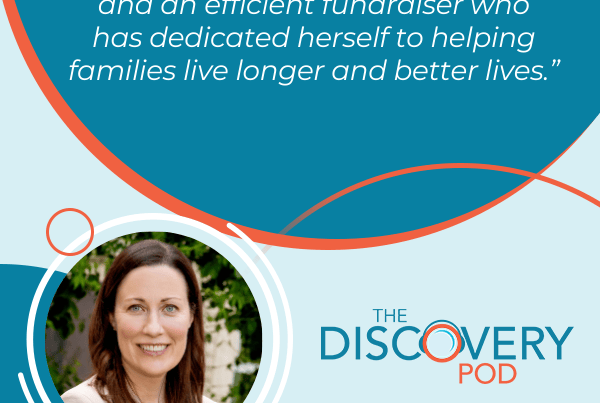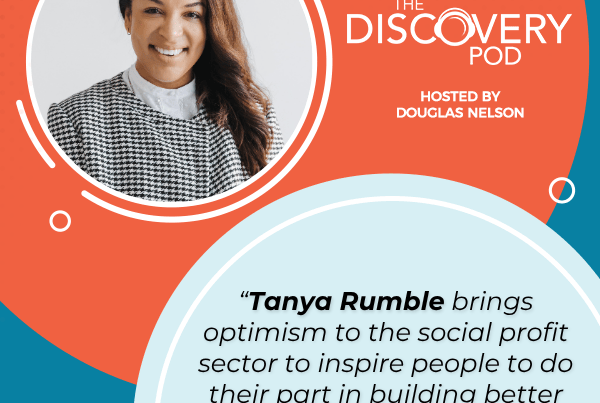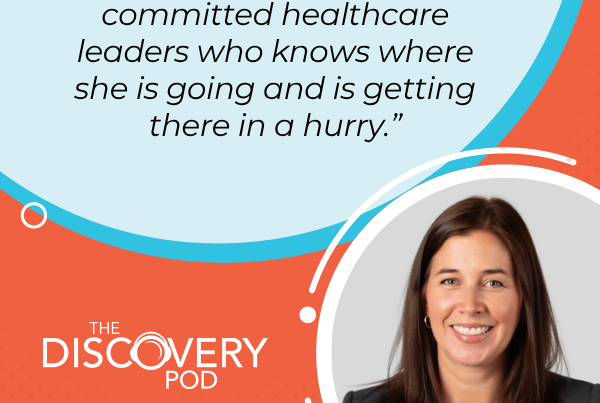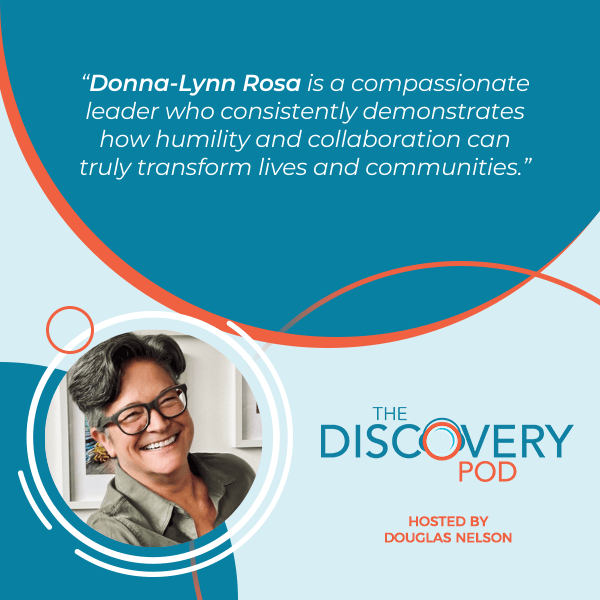
What does it take to scale impact without losing sight of humanity? In this Women’s History Month conversation, Douglas Nelson speaks with Donna-Lynn Rosa, CEO of Atira Women’s Resource Society, about leading with humility, compassion, and hope. From one house four decades ago to more than 2,500 supportive housing spaces today, Atira has become British Columbia’s largest provider of housing for marginalized women, children, and gender-diverse individuals fleeing violence. Donna-Lynn shares the organization’s person-centered approach—where nearly 80% of staff bring lived experience—and its dual focus on providing immediate services and driving systemic change. She also reflects on her leadership philosophy, showing how pausing, listening, and modeling wellness are key to sustaining both people and mission while tackling gender-based violence and advocating for a safer future.
—
Listen to the podcast here
Scaling Impact While Staying Human With Donna-Lynn Rosa, CEO, Atira Women’s Resource Society
In this episode, in honor of Women’s History Month, we’re proud to welcome Donna-Lynn Rosa, CEO of Atira Women’s Resource Society. Donna-Lynn leads with a deep commitment to community and equity, driving Atira’s mission to support marginalized women, children, and gender diverse individuals. She brings extensive experience in municipal government leadership and parks board leadership, as well as expertise in housing, mental health, and a great depth of work in indigenous community leadership.
Donna-Lynn is known for her fair and compassionate approach to transformational change, and her leadership is rooted in collaboration and centering voices often left out of decision-making to ensure inclusive solutions that meet real community needs. In this episode, she talks about her own leadership journey, the vital role that our organization plays in the creation of community in Vancouver’s downtown East Side, and how individuals can get involved in solving the underlying issues that make the work of Atira so critically important. This is an episode focused on leadership and learning. I invite you all to enjoy my conversation with Donna-Lynn Rosa.
—
Welcome to the show.
Thank you. It’s great to be here.
Donna-Lynn, I’m so looking forward to our conversation. You’ve got a great organizational story to tell and an interesting leadership journey to share with our audience. Let’s start with start at the top as we do. Talk a little bit about Atira, the great work that you do, and the community that you serve.
From One House To 2500 Spaces: Atira’s Remarkable Growth
Thanks. It’s such a privilege to be the CEO of Atira, but it’s such a privilege to be able to talk about it, because right now, especially this time, this political climate, the work we do in the community is supporting women, children, gender-diverse folks as they flee violence. Seeing what’s happening around us and in our own community, we know that there’s a huge need for us to be supporting people, and not just women, children, and gender-diverse folks, but especially them. They’re the most vulnerable.
Atira started many years ago with one house in South Surrey, recognizing that there was a gap. It was a group of visionary women who came together and recognized, “We need to be able to have a place for these women to go and be safe.” The notion that we offer SROs, a Single Room Occupancy, we offer shelters for everybody, including women, did not mean that women would be safe. This has grown into a tier providing more than 2,500 spaces, being BC’s largest provider of supportive housing.
It’s a remarkable story of growth, but not just growth for its own sake, but growth to purpose. From that one house in South Surrey to where you are now, how do you get from one house meeting an immediate and acute need in the community to a complicated, complex, fully formed organization, housing 2,500 people?
Not only do we house 2,500 people, but we also serve thousands of people in terms of our programs and our outreach, and the support services. How you get there is one need at a time. What Atira has been known to do is to recognize people as complicated human beings. While one person might have this journey ahead of them and be self-determined, another person may have another journey.

Scaling Impact: Atira has been known to recognize people as complicated human beings.
We can’t just say, “Here’s the service you have access to. Go on your journey.” We have to look at the services folks need. Some people need access to legal assistance. Some people need access to safe drug use. Some people need access to understanding how to care for their pet. Some people need job awareness, job experience. It is a personal journey. You and I have had different journeys in this world, and we’ve had different supports along the way.
The same should be available to anyone.
Exactly. Atira’s goal is to walk alongside women, children, and gender diverse folks, but to walk alongside our clients to support them in their agency around their definition of what their hope and their journey are.
Housing To Hope: Defining Individual Journeys
One of the things that is so powerful about the organization is a phrase that comes up when people talk about Atira and how you communicate your message to the broader community about that. It’s “From housing to hope.” What does housing to hope represent, and how does that show up on a day-to-day basis at your organization?
Fundamentally, we believe that everybody deserves adequate and sustainable housing. We don’t think that people deserve to be put into 100-year-old hotel rooms that are converted and meant to be temporary. We believe that people deserve the dignity of a house, and that could be purpose-built, which we have. It provides people a space that is filled with dignity, and there are supports tailored to the level of support needed.
Everybody deserves adequate and sustainable housing. Share on XIn some cases, we need shelters. In some cases, we need to be able to go out to encampments or along the street to do outreach for folks. The hope is exactly what I was saying about everybody’s definition of hope is different. Mine and yours are different. All the people that we work alongside, that we walk alongside, we listen to them. We understand what their definition of hope is. It may be entirely different than my definition or your definition. It may be that I’m going to make it to lunchtime today. It may be that I’m going to see my kids this weekend, or this day. It could be anything. What it isn’t is my definition of hope for them.
That is such powerful messaging, and it resonates to hear it. Living and breathing that as a larger organization presents its own challenges. How do you keep that top of mind as a leader?
I have the privilege of working alongside so many folks with lived experience. We lean into that as one of our greatest strengths at Atira. Pretty close to 80% of our staff come with lived experience. Who better to walk alongside you than somebody who has experienced it and is humble and knows that their journey, not your journey, but I’m here to walk alongside you because I had my journey too.
The way that I keep it in check is that I’m real. I’m surrounded by some solid humans who understand that we are all messy, and that we have to do what we have to do to take care of ourselves in order to show up as best we can for others. As best we can means no ego, with humility and understanding that this is a moment when we are not the smartest ones. I’m not the smartest one in the room when it comes to this. I bring something to the table, but the people who have the most knowledge are the people who have lived it.
Leading With Humility: Insights From A Municipal Government Background
Given your background, you’ve been in charge of some fairly large bureaucratic places, even Chief Administrative Officer of the Parks Board, and as well as Chief Administrative Officer of the City of Vancouver. You know what big systems look like and what big organizations can do, and some of the challenges of them. You are leading another large organization with a complicated mission, managing fewer people. All of your answers in our conversation to date have been bringing it back to the individuals that you’re serving or the individuals that you’re working with. How do you think at scale and operate at scale through your organization, and keep that connection to the individuals so close to your heart?
How does one not do that?
I’m sure you could think of lots of people who don’t do that.
Yes. Those aren’t the examples of success that I lean into. I have worked in large bureaucracies in the East and also here. I worked in a setting where I got to where people and go to the community. That was the pinnacle of my success, where I was able to show up and have conversations. At the end of the day, when you’re in municipal government, my job is to understand what the people want and then to deliver on that.
There are budgets and there’s policy and all that in between. If I don’t know where I’m going, anywhere will do. When I left the bureaucracy, and I went and worked with the Squamish Nation, what I learned was that it did not matter what title somebody held in the daytime job, because when we went into the longhouse, maybe they were the most respected person there. Maybe they had a responsibility that was something I had no idea about. Frankly, I was a visitor in that space. As a good guest, I was there to learn, and I was there to make sure that I respected the space I was in, the culture I was getting the privilege of witnessing.
Spending time with the Squamish Nation taught me a lot more about humility, a lot more about true leadership, not colonial, misogynistic, or dictatorial. True leadership is the people who people want to follow because you’re showing up authentically, and you’re showing up with curiosity, and you do your best. I do my best to make sure that I’m not making decisions from ego. It’s an everyday thing that I have to consider when my ego is taking over. I do recognize when I’m in judgment, because when I sit in judgment, I make bad decisions about myself or others. That humility and that ability to show up with humility open up a whole world.
When we sit in judgment, we make bad decisions for ourselves or others. That ability to show up with humility opens up a whole world. Share on XWhen those moments occur when you catch yourself, or maybe it’s a brief reflection that was a moment of judgment to you of yourself or others, is there an alarm that goes off somewhere?
I can say that I’m only recently recognizing that it’s a thing that is present. I wish there were an alarm. There is, because I know when I’m sitting in judgment. I know when I’m judging myself. I know when my whole body doesn’t feel regulated, to be honest. I know when my ego is taking over. To me, the best thing I can do is pause. There are so many things we all do, whether it’s running, swimming, cycling, reading, yoga, or meditation. All the things, and I do. In the moment, remembering to pause and not have to have a reaction to everything right away, I don’t know if it’s a way to lean into your humility around something. It’s also a way to bring other people’s voices forward. People wait for the leader to say something, and I’m never going to learn if I’m the only one talking.
Modeling is one example of how you bring that ethos to your organization, and maybe the most important. Are there other ways that, for those working most closely with you at Atira on a daily basis, they would know that that’s how they’re expected to be open and show up?
As leaders, we have to be vulnerable enough to openly model and to say, “I’m sitting in judgment right now, so let’s know that.” I’ll take a deep breath and see if I can come back to not being in judgment and understand that we are all human, and it’s going to happen. When I understand that it’s going to happen, then I can sit back and go, “That’s my reaction. What’s the reality?”
It’s important as leaders, too, that we model the way of healthcare, like personal wellness. That comes from being honest with myself about where I’m not in alignment or where I’m not in good practice. If I’m sitting at 9:00 at night and doing emails, guess who is also responding to emails at 9:00 at night? That’s my staff. If my team is doing that because they think, “The CEO is constantly on,” then they’re constantly on. That’s a fast road to burnout.

Scaling Impact: It’s important as leaders that we model personal wellness in healthcare. That comes from being honest with myself about where I’m not in alignment or good practice.
This is one of the things that my team and I put in place when I worked at the parks board. At the parks board, I’ve always worked in 24/7 operations. After 5:00, if it’s important, text. Take it off email. If it’s an emergency, call me. I can still be available, but let’s not do those emails where I’m hearing ding. Actually, I turned that off too. Let’s not do those emails and then have staff feel like they have to be responding at all hours. We know that they model our behavior. If our behavior is instead of I am posting on LinkedIn, I’m out for a run, or I am out for a bike ride, that is modeling good human behavior.
That’s an important lesson and great advice for leaders in our sector. I took that advice in my career when I was a first-time CEO and mangled it. I understood that because I had a boss earlier in my career who would send emails all morning Sunday, and then all late evening. She had the Monday blues. She would email on Sunday and get it all out. There was a tacit assumption that you would respond to the Saturday emails, and then you would get a response to what you had done. It meant Saturday afternoon, and Sunday morning is when you’re supposed to be responding.
I was like, “I’m not going to be like that. I’m going to do it differently.” I started out and caught myself sending weekend emails. I said, “I’m going to hit that schedule send to 7:00 AM, 8:00 AM, or 8:30 AM.” I did that for a few months, thinking I was super progressive and a great boss. One of my colleagues pointed out how dreadful it was to receive four emails the first thing on Monday morning, so that’s not the answer.
We think we have workarounds when, in fact, it’s as important that you’re putting on your mask. It’s as important that you’re putting your phone away. I want to show up for my team as a well human, like a well person. In order to be well, I’m learning. This is only recently that I need to start my day in a certain way. I can’t just roll out and roll into things and be all on. I need to ground into the day. Learning more about myself has positioned me to become a leader who is not creating more angst than we already have in this world. I’m not creating situations where I am escalating the temperature or causing grief for people. The work itself is hard enough. Interacting with me should feel supportive, not like another task.
Boardroom Wisdom: Strategic Planning And New CEOs
Given your professional background and reporting to the city council and the parks board, and now with a board there at Atira, it’s one thing to show up for your leadership team where you’re in the position of authority and say, “This is the standard that we want to set and represent.” Not every leader does enough to take advantage of that responsibility or that opportunity, but you have a lot of agency as the CEO to set that standard.
It can be more challenging to set that standard in a conversation with the board. How do you approach that? We’re walking alongside our clients, we’re walking alongside each other. That is so important to the ethos of the organization. How do you communicate the value of that and demonstrate that in conversation with boards?
There are a few ways. One would assume that people join a board because it’s aligned with their values. Making sure that every time we come forward to the board, every communication we have, we’re level setting with these are the values, this is the mission, and that’s their direction to staff. If they want to change the mission, vision, or values, then they have every right to do that. That’s where we report out on.
Atira grew so fast over that period of time, and like the rest of the sector, the administrative part of it didn’t keep pace with the need and the service. It’s not a material thing. This is a sector-wide thing. I’ve experienced it in government, too. Catching up on the administrative support for the services means that you’re constantly working. Sitting back long enough to go, “Let’s do a stratplan. Let’s bring the board and staff together to align the vision.”
The first thing that I was part of when I joined Atira was doing a bridge plan, because as a new CEO to an organization, maybe setting the stratplan for 3 to 5 years, and we had a fairly new board, it was too early to do a full-on 3 to 5-year commitment because anything could change. Atira was in transition. We smartly did a bridge plan of eighteen months with a very clear focus of stabilizing the organization, returning the reputation to be the trusted voice in the community, and supporting the staff while right-sizing to our mission.
We are finishing. We’re delivering on that, and it’s my one report card to the board. That’s it. If I deliver the stratplan, I’ve done my job. Part of that is now we’re ready to do a 3 to 5-year stratplan. As a CEO who has over a year of experience in this and staff who I know have 15 to 20 years’ experience in this, we as a team can now lean in and support the board to develop a stratplan that will guide us for the next 3 to 5 years. That’s how we stay aligned to the mission and vision. We get the buy-in from the board, but we are also getting buy-in from all levels of staff, because right now, they’re in the discussions that are informing our SWOT analysis and stuff that we are going to bring to the board and go, “Here’s the picture.”
The wisdom that you shared there, I hope everyone captured. When we’re working with new CEOs coming into organizations, it’s very often the case that we want to encourage them not to jump into a stratplan. Often, board members will be saying, “We knew we needed a new CEO, or we got our new CEO, now let’s do the stratplan.” It’s the next line on their to-do list as boards. I don’t think that’s the appropriate to-do list, but that’s often the case.
Particularly, first-time CEOs often find themselves in the position of having to say no, or worse, they say yes and then they do a strategic planning process right out of the gate. We often encourage 12-month, 18-month, “Here’s what we’re going to focus on for this period of time, so that we’re ready to set that big plan.” It takes confidence. It’s a big challenge to push back against the board that’s saying, “The strategic plan is ours to own,” but not yet. Every situation has its own circumstances, but you identified it coming in that “We’re not ready to do strategic planning.” How did you communicate that to them?
When I joined Atira, when they brought me here, they said that this organization is in transition. When the topic of the stratplan came up, I openly said, “I don’t know what the stratplan should be for this organization. I’m looking around at a lot of new faces, some returning faces, and I’m curious to know, does everybody have an idea, or do we need to just breathe?”
As I said earlier, the biggest gift I give myself in order to be successful in any conversation is to pause. This was the big pause button. I was lucky that there were a few board members who saw that that was more important than checking if we have a stratplan, because it is a stratplan. It’s just a short enough stratplan that we’re not committing to a 3 to 5-year plan.
Back into that boardroom that you had us in, hearing the very experienced, highly successful, with a tremendous track record, new CEO we brought into our organization, and who is sitting in the boardroom saying, “I don’t know what our strategic plan should be,” that must be terrifying to hear.
I’m sure it was. In retrospect, they may have been questioning whether or not it was the right choice, but it was honest.
Not for long, if they were. They probably weren’t. If they were, I’m sure it was not for long.
I needed to be honest that if they wanted my best work, give me a minute to get a feel of this organization. Give me a minute to talk to the people who are doing the work. Give me a minute to understand the services we provide. It’s one thing to read it on the website, it’s another thing to go out. In my first 3 to 6months, I went and met probably 85% of the staff. A year later, I’m back on the road again.
I was out at a staff meeting. I think that’s a critical way to understand what’s going on. That’s how I got to learn. Now, when I’m guiding the stratplan, I have people’s faces in my mind, thinking, “How is that person tied to this vision, this stratplan? What does it mean to that frontline person who works the midnight shift, supporting women in a shelter? What does it mean to her?” I can now connect the dots better than when you asked me a year ago. I had no idea because I hadn’t even been to that shelter.
The idea was theoretical a year ago, and it’s tactical and lived experience now.
It is significantly different.
Balancing Crisis Response And Big Picture Change
What a year in terms of the leadership journey we’re talking about. I appreciate your candor in talking about how you think about this. I think it’s valuable for our audience. You use the evolution language a lot in how you’re describing the work of the organization, and even how you describe your work as a leader. You’re working in a space where urgency and crisis seem to be the coin of the realm a lot of the time.
Many of the issues of the people you serve are accelerating, getting worse. As an organization, not just you as a leader, how do you prepare to respond to those moments of crisis, urgent, quick snap reaction? Phone call on the weekend rather than the email, and maintain the ability to pause and look at that bigger picture.
First of all, if my reaction to everything was to have a reaction and be immediate, then everything is going to escalate my state. Likewise, everything is going to escalate the state of the organization. The first step is that pause to go, “Is this a real emergency, life and death thing? Is this a perceived emergency? Do I have a little more time, or is this unknown? Can this wait? Can I gather more information?
I’m going to say, even in this life and death situation, the majority of the time, by the time I’m involved, the life and death part has already been addressed because the staff are trained and they’re doing it. They’re not waiting on direction from me. If I have to tell somebody during the game to shoot the puck, then practice has not helped.
Ultimately, I shouldn’t have to say that. They have been trained, they know what they’re doing. By the time it comes to me, we’re usually debriefing or we’re in, “How do we address this for next time, or how do we now communicate it out?” That pause button, especially at this level, is crucial because oftentimes, when it comes to me, if the people coming to me are escalated, it’s not going to help if I’m escalated. Understanding the triage process and then bucketing it into what needs immediate attention. If everything is important, nothing’s important. I hate to say that.
It’s so true. One of the things that is fascinating to me about the organization is the emergency services provided for individuals fleeing violence and in crisis. One of the things that Atira talks a lot about is how to address the root causes of gender-based violence and addiction. There’s the big picture, social change, systems change, policy, and government advocacy being very public. Let’s change the way society works in some important ways. The very tactical how we address the needs of this woman or this person right in front of me. How do you think about working at that level of the vital transaction, the provision of service, and those conversations about social and societal change?
There’s the granular and then the macro. The granular is where we have to be the most human and where we have to show up as ourselves for people. That’s where supporting my team to be able to show up day in and day out with support and hold space for other people in their trauma, that’s part of the everyday work we do to support our team who are out there. As far as the policy, we have the back-of-house policy people and the advocacy people. Quite honestly, it runs through the organization, of course, but it becomes clear that when you’re a trusted voice in a sector, you have an accountability to the people you serve. You have a responsibility to speak up.
When you're a trusted voice in a sector, you have an accountability to the people you serve, and a responsibility to speak up. Share on XI think one of the most critical things that Atira can do is be a voice at the table in collaboration with all the service providers. What has happened when it comes to gender based violence and intimate partner violence, we work collaboratively across the sector with folks to elevate our impact through our combined voice. Writing and influencing policy at the national level is a lot easier when you have representatives from so many organizations that are trusted.
When you bring us all together, you’re bound to get the best ideas out. That work, influencing gender-based violence being called an epidemic here in BC, is important work and keeping it at the forefront. In the last 2 or 3 weeks, we’ve had five women here in the Lower Mainland who have been murdered, intimate partner violence, gender-based violence. How is this not a topic that everybody is talking about? How is this not a topic that needs to be addressed? It’s not women who need to be addressing this.
We are addressing it. Women are doing the advocacy, and we’re supporting women from fleeing those spaces because what we know is that if women don’t come into housing, the majority of the time, they’ll go back into a violent situation, a dangerous situation. That’s because our policy doesn’t necessarily protect them as a society. We don’t have the housing to put them in. We turned away 5,000 people in 2024. We know that we don’t have the capacity to serve. Our mission and vision are to serve. The advocacy part is a critical part, because if we don’t get that right, then our need to provide services will continue to outpace our ability to serve.
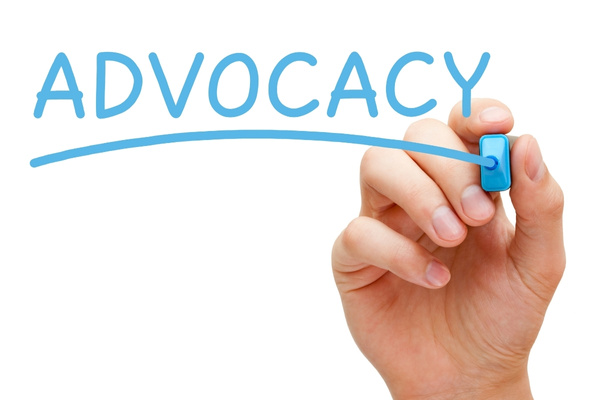
Scaling Impact: Advocacy is critical; without it, our need for services will always outpace our ability to serve.
The Epidemic Of Gender-Based Violence: Advocating For Policy Change
That’s a sobering number that five women have been killed in the Lower Mainland in the last little while. I was in a conversation with a board, and the conversation was referring to intimate partner violence as an epidemic. Someone said, “What does that change? Is that a real thing?” What does that change, Donna-Lynn?
Once it becomes a narrative with proper facts and proper information around it in the social construct, in the social dialogue that happens, you start to have people become aware. That’s when the real collaboration can start. That’s when the policy change can start. The very fact that a woman or any partner, but in most cases, it’s women, can call the police, report an incident, and have it addressed ten years ago has not been taken seriously. Women went missing from the Downtown East Side. People didn’t pay attention because they were from the Downtown East Side.
Awareness means that we’re talking about it, and we are going to have traction on policy change and action change. We are going to have an action change, and behaviors and norms will change. We know that years ago, you could smoke in your office. Now you wouldn’t even think about it. We need to change the social norms around intimate partner violence. We need to change the narrative that we only need to protect women. We need to be holding our men accountable. We need to be growing boys who respect women.

Scaling Impact: We must change social norms around intimate partner violence. We need to shift the narrative from solely protecting women to holding our men accountable.
It shouldn’t be evolutionary.
No, but it feels like it might be.
The need for change and the need for additional services, we need to change, meet the need today, and change society so that the need today doesn’t exist in the future, or is significantly diminished in the future is holding a lot in your hand as an organization and as an organizational purpose. How do you communicate that to your community of supporters, whether they be funders or donors, or just allies in the community?
In my first months on the job, but especially my first two weeks, I spent a lot of time walking through the Downtown East Side. I remember asking one of my team, “How do you walk past people who are slumped over?” I recognize that they stopped to make sure that somebody was breathing. I was like, “How do you walk past somebody and go home at night? How do you reconcile seeing, witnessing all of this?” They gave me some great advice. They said, “The faces that they see are the faces of the people who we are walking alongside.”
As an organization, if we can focus on what we can do, if we spend all of our time focusing on what we’re not achieving, there are service providers across the board who are doing this work with us. We need to focus on the faces of the women and children, gender-diverse folks, and mixed-gender folks. We need to remind ourselves that these are the ones in our services. Certainly, that doesn’t mean we’re discarding the others, because if they came into our service, we want them. You have to put a focus on the good work that’s happening.
Hope As A Leadership Strategy: Kindness Over Fear
That is such a powerful message and such a great lesson for most of our social profit sector. Thank you for sharing that. What are you looking forward to?
We have a new housing minister. I’m excited to work alongside Christine Boyle. I think that if we continue to keep hope as a leadership mantra, then we’ll find a way. I can say without ego, when I started in this role, I didn’t understand hope as a way forward. I was like, “You can’t lead from hope. You have to have a plan.”
The closer we understand that leading with hope and kindness is an everyday thing, the more successful we are as a leader. Share on XHope is not a strategy.
In fact, it is. What I’ve learned in this role is that the only strategy I have any control over is whether or not I have hope, because the rest of it is going to play out. I might have this much influence on it, but the hope that I bring into the job, the hope that I bring as I show up face-to-face with my team, that’s hope as a leadership strategy.
Let’s be real. I grew up in a colonial construct, a bureaucratic construct. I’m going to say it. I had a lot of older White dudes who said to me, “You’ve got to be tougher. You’ve got to be stronger. You’ve got to be mean sometimes. People need to fear you to follow you.” I resisted that my entire career, and it didn’t serve me well with them when it came to my evaluation time.
When I went home at night, I could look in the mirror and go, “Actually, I inspired people to be their best, most authentic selves today.” I didn’t use fear as a motivator. I didn’t use anything but kindness. The further we get from that, the more damage we cause as leaders, the closer we get to understanding that leading with hope and kindness and it’s an everyday thing. Every day, I have to check myself, every moment. Again, I say, “Is my ego in this? Am I judging or am I truly leading with hope and kindness?” Strategy is going to be there. It’s part of it. You’re going to have a strategy. How I do it, that’s important. To me, that’s what makes a successful leader.
Donna-Lynn, you are demonstrating that you and your colleagues at Atira are doing incredible work. I wish you great success and continued hope. Thank you so much for being on the show.
Thank you. It’s been a pleasure to chat with you.

